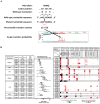Mutational processes shape the landscape of TP53 mutations in human cancer
- PMID: 30224644
- PMCID: PMC6168352
- DOI: 10.1038/s41588-018-0204-y
Mutational processes shape the landscape of TP53 mutations in human cancer
Abstract
Unlike most tumor suppressor genes, the most common genetic alterations in tumor protein p53 (TP53) are missense mutations1,2. Mutant p53 protein is often abundantly expressed in cancers and specific allelic variants exhibit dominant-negative or gain-of-function activities in experimental models3-8. To gain a systematic view of p53 function, we interrogated loss-of-function screens conducted in hundreds of human cancer cell lines and performed TP53 saturation mutagenesis screens in an isogenic pair of TP53 wild-type and null cell lines. We found that loss or dominant-negative inhibition of wild-type p53 function reliably enhanced cellular fitness. By integrating these data with the Catalog of Somatic Mutations in Cancer (COSMIC) mutational signatures database9,10, we developed a statistical model that describes the TP53 mutational spectrum as a function of the baseline probability of acquiring each mutation and the fitness advantage conferred by attenuation of p53 activity. Collectively, these observations show that widely-acting and tissue-specific mutational processes combine with phenotypic selection to dictate the frequencies of recurrent TP53 mutations.
Conflict of interest statement
M.M. is a consultant for OrigiMed and receives research support from Bayer. W.C.H. is a consultant for KSQ Therapeutics.
Figures




References
-
- Petitjean A, et al. Impact of mutant p53 functional properties on TP53 mutation patterns and tumor phenotype: lessons from recent developments in the IARC TP53 database. Hum Mutat. 2007;28:622–9. - PubMed
-
- Milner J, Medcalf EA. Cotranslation of activated mutant p53 with wild type drives the wild-type p53 protein into the mutant conformation. Cell. 1991;65:765–74. - PubMed
-
- Harvey M, et al. A mutant p53 transgene accelerates tumour development in heterozygous but not nullizygous p53-deficient mice. Nat Genet. 1995;9:305–11. - PubMed
Methods-Only References
Publication types
MeSH terms
Substances
Grants and funding
LinkOut - more resources
Full Text Sources
Other Literature Sources
Research Materials
Miscellaneous

